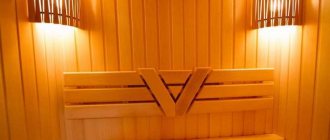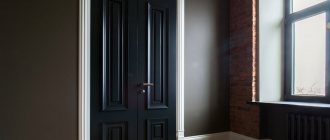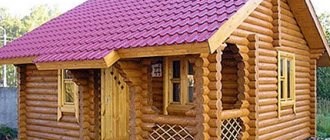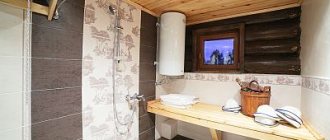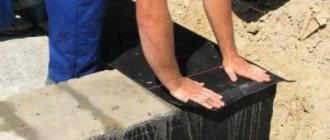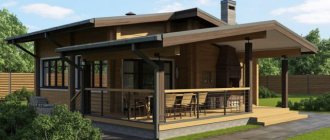The bathhouse is a unique place. Here you can take a break from the hustle and bustle of your days, relax after hard working days, and meet with old friends. An important attribute is wooden doors for a bathhouse. Choosing doors is a rather difficult task, because the operating conditions are quite complex. Wood is affected by high temperatures and high humidity.
Requirements for a bath door
A real traditional Russian bathhouse is built from wood. The interior of the room is also made of wood. In order not to violate long-standing traditions, the door should also be made of wood. But it is very important that the door leaf can withstand temperature changes and constant exposure to moisture. Also, the door leaf should look stylish, because bath procedures are not only health benefits, but also real relaxation for body and soul. Therefore, aesthetic characteristics are very important.
Wooden doors to the bathhouse have many different advantages:
- High-quality wood is environmentally friendly;
- The smell of natural wood not only gives a pleasant feeling and helps you relax, but also has a positive effect on health;
- Wood has a low level of thermal conductivity and retains heat well in steam rooms and saunas;
- Doors are often made in a classic style and will bring pleasure to connoisseurs of bath traditions.
But among the advantages there are also several disadvantages. Since the door leaf is constantly exposed to steam, moisture, and high temperatures, the product may become deformed or shrink over time. So, you have to remove the canvas and rearrange it so that it then falls into place and the door can close tightly again. If it doesn't close tightly enough, steam escapes from the room.
This is the only drawback that wooden bath doors have. Nothing more can be said about the minuses.
Conclusion
Now you know that you can not only build a bathhouse yourself, but also make a door in it so that it can maximize heat retention in a given room. All you may need to implement your plan is a little patience, attentiveness and a little free time, and at the end of the work you will receive an ideal product that will help you extend the service life of the structure you have built several times (read also the article “Do-it-yourself sauna shelves : subtleties of manufacturing").
You can get more detailed information on this topic from the video in this article.
Did you like the article? Subscribe to our Yandex.Zen channel
Types of doors
Wooden doors for a bathhouse can be made in the form of a solid structure. Among the advantages of this design are lower susceptibility to deformation and resistance to high temperatures. The cost of solid wooden doors is quite high, but the quality is also high. Take a look at what bath doors look like. These wooden doors are very traditional, you can see one of these in the photo below:
Combined models are also popular - glass inserts are built into the canvas. Often, they use not ordinary glass, but special glass. It is highly durable and can withstand high temperatures. It can be of several types. Thus, there are tempered glass, transparent, frosted or corrugated.
Materials
As for the breed, it is most often linden. However, sometimes some other types of wood can be used.
Linden has all the necessary characteristics that are relevant in baths and saunas. For example, linden wooden entrance doors for a bathhouse can last a very, very long time. The door leaf has high strength and resistance to operation in adverse conditions. Linden also emits a very pleasant aroma. Linden sheets retain heat well, which is very important for a bathhouse. Such products do not swell, do not emit resins, and are very pleasant to the touch. Linden is an excellent solution both as an entrance and as a door to a steam room.
Linden is not the only material used in the production of bath doors. In addition to linden, abash, Canadian cedar or ash are successfully used in industry. The technical characteristics of these breeds practically do not differ from each other - the only difference is the cost. But at the same time, all the characteristics are kept at the linden level. Therefore, it is considered the most optimal and affordable option.
But fashion is slowly taking its toll and many people prefer oak products. The main difference between these wooden doors to the bathhouse is the greater weight of the door leaf and higher durability.
TOP 5 main types of wood for lumber
| Photo | Name | Rating | Price |
| #1 | Larch | 100 / 100 | |
| #2 | Cedar | 99 / 100 | |
| #3 | Pine | 98 / 100 | |
| #4 | Fir | 97 / 100 | |
| #5 | Spruce | 96 / 100 |
Larch
Larch is a special type of softwood often used for lumber. In strength, it is second only to yew and oak, and its ease of cultivation and processing ensures a low price compared to elite types of wood. It is slightly susceptible to environmental influences and is resistant to moisture and sun. This is a good material that is used for floorboards, floor beams and creating walls.
Larch Pros
- high strength and moisture resistance;
- durability;
- low susceptibility to warping.
Minuses
- high thermal conductivity;
- There is a possibility of internal cracks appearing due to improper drying technology.
Cedar
Cedar is an expensive wood used for finishing buildings and creating load-bearing structural elements. In fact, products made from real cedar are almost impossible to find on the CIS market, because it grows only on a few islands in the Mediterranean. The alternative used is Korean pine, often named after this rare tree.
Cedar Pros
- resistance to rot and wormhole;
- high strength;
- minimum defects (radial cracks or ring delaminations).
Minuses
- has a specific woody aroma;
- Cedar wood is very expensive.
Pine
Pine wood is considered universal in woodworking because of its qualities. It has a lower density than larch, but processing costs are lower. Pine contains a high proportion of resins, so its durability is high. This material is used for beams, boards, logs and beams, as well as facing material. It is pine that is most often used to produce lining.
Pine Pros
- environmental friendliness;
- strength;
- long period of operation;
- easy repair.
Minuses
- pine wood is soft, easily scratched and damaged;
- Resin stains may form on the walls.
Fir
Fir is rarely used for lumber, because it requires lengthy processing. This wood has high natural humidity and low moisture yield, which is why it needs to be dried long and hard using special ovens. Therefore, this material is used only for cladding.
Fir Pros
- wood is practically odorless;
- does not contain resin.
Minuses
quickly rots and is destroyed by wood-boring insects.
Spruce
Spruce lumber has a low price and is widely available. It is a simple wood often used for cladding. Spruce timber is almost never produced; more often it is used to make saw logs or lining.
Spruce Pros
- spruce wood is practically not subject to warping;
- sticks well.
Minuses
- high humidity;
- large deformation during drying;
- a large number of branch bases.
Doorway
In bathhouses of modern design, special stoves or electric fireplace systems are used. Thanks to this equipment, the room is constantly maintained at comfortable and required temperatures. If cold air enters a room, it will heat up almost immediately. Even more - modern equipment requires a constant small flow of air to operate. The wooden door for the bathhouse at the bottom has a small gap, which solves the problem of ventilation.
The optimal size for a doorway in a steam room is 1.8 x 0.8 m. At the same time, the ceiling height should be approximately 2.2 m. You need to know that in a traditional steam room the distance from the top door strip to the ceiling should be at least 40 cm. All depends on the door design. In the case of a wooden door, there may not be a threshold.
Insulation
When the dimensions of the door are determined and the material from which the structure will be constructed is also selected, you need to take care of purchasing raw materials for insulation.
Although wood, as already mentioned, is a fairly durable and heat-retaining material, it still needs to be additionally insulated to create a better atmosphere in the bathhouse.
Do-it-yourself insulation of a bathhouse door is usually done using mineral fibers, cotton wool, felt; polystyrene foam is also used for this purpose.
The upholstery needs to be fixed over the insulation. It can be leatherette, plywood, or wood, which is popular among owners of private houses.
In any case, the door leading to the bathhouse must be insulated.
Door to the steam room
More stringent requirements are imposed on this wooden bath door. It is necessary to choose a solid structure that is made entirely of wood. Experts recommend using single-leaf door leaves for steam rooms that open outward. Despite the simplicity of execution, this design is very effective.
It is believed that the door leaf should not be equipped with locking systems, but at the same time the leaf should close tightly and not open. To achieve this effect, the canvas and jamb are installed at an angle relative to the floor so that the canvas is securely held under the weight of the canvas.
It is also believed that solid wooden bath doors should be no higher than 1.5 m, and their width should be no wider than 50 cm. The door threshold should be from 10 to 15 cm in height.
Determining the dimensions of the structure
The diagram shows the main dimensions that should not be changed
Openings in self-built baths, as a rule, differ from standard ones. Therefore, before making a door and frame for it, it is worth carrying out basic calculations:
- Using a tape measure, measure the width and height of the opening according to the level to avoid errors due to skew.
- Subtract 6 cm from the resulting width and 3 cm from the height. This way you will get the external parameters of the box without taking into account the threshold. It is better to determine its thickness when the door is ready in order to level out possible errors.
- From the width of the box, subtract the thickness of the timber that you plan to use (the most popular is 110x60 mm) and another 6 mm (the required gap on both sides). This will be the final width of the finished door.
- To determine the height of the door, subtract the thickness of the beam and another 18 mm from the height of the frame (3 mm gap at the top and 15 mm ventilation gap at the bottom).
If the result obtained differs from standard models by only 1–2 cm, you can make a standard door and simply use thicker bars to secure the frame in the opening.
Quality and safety
Like any thing, wooden bath doors must meet certain requirements. The product should reduce heat loss as much as possible. There should be absolutely no gaps or even small cracks between the canvas and the box.
As for the front door, it serves as a kind of shield, which must be very strong. Any door panels that will be installed in baths or saunas must open outward - this is a safety requirement.
The fittings, in particular door handles, require special attention. Both hinges and handles must be treated with special solutions or varnishes that can protect the metal from corrosion and damage. Iron handles can reach very high temperatures. Therefore, you can get seriously burned by it. It is recommended to purchase products made from alloys that can withstand high temperatures without heating up. Brass hinges are recommended. They are not subject to corrosion.
Despite the fact that the entrance wooden door for a bathhouse does not actually solve important problems and is not exposed to steam, it should still be treated with a solution. Varnishes or solutions for treatment must have moisture-repellent properties and prevent swelling and deformation. If you treat the canvas with this complex, the product will last for many years.
Choosing a door: what you need to know
When choosing a suitable product, in order not to make a mistake, you should take into account both important characteristics and finances. The best option from both a functional and economic point of view is a blind door structure made of linden.
If your goal is to surprise guests and friends with traditional and impeccable bath interiors, you should think about purchasing luxurious linens made from valuable species. For those who want the interior to be not traditional, but rather modern, it is recommended to opt for elite combined models with tempered glass inserts.
Safety in a bathhouse is very important and wooden bathhouse doors must meet all its requirements. So, for a steam room it is necessary, as already noted, to choose the right fittings. Experts and those who like to take a steam bath in a traditional Russian bath do not recommend fashionable stone products - they become very hot during the process and you can get serious burns from them.
Fire safety for a door to a steam room is also an important requirement. The canvas should be as fire resistant as possible. Today there are many compounds on sale that will give wood these necessary properties. They can also significantly extend the life of the product.
Which model to choose is a personal matter for the person who chooses the door. You just need to remember about resistance to humidity and high temperatures - this is the key to high quality.
How to properly insulate?
A simple way to insulate a bath door is to take bars and make a frame out of them, nailing it to the door with a 15 mm indent from the edges of the door leaf. And to fill the empty space inside the frame, a sheet of hardboard is placed, increasing the heat resistance of the door structure. When the door is closed, the insulation bends, blocking the flow of cold air. Other options are also possible. For example, to insulate a bath door from the cold with energyflex, this material is secured along the edge of the panel with a construction stapler. Metal slats are attached on top of everything for secure fixation. The whole job takes no more than 10 minutes.
It is possible to create a thermal curtain:
- First, let's prepare the sealing frame. Using the example of a door leaf measuring 80×180 cm, it is necessary to make 2 strips of 10×100 cm and two 10×220 cm from the seal. Then the strips are nailed along the edge of the leaf at a distance of 2 cm from the door frame.
- Next, we will make two pairs of bars, one with a size of 184x2x2 cm, the other - 80x2x2 cm. The bars are nailed on top of the insulation on the door frame. After this, the bars are wrapped in insulation, and the remains are removed. Then we make a leatherette or canvas screen 120x200 cm. We attach the fabric to the canvas, turning it on the left side to place a 2x2x200 cm block.
- We attach the 10 cm block remaining after cashing to the wall with the right side. The edge of the bar is covered with a decorative strip and rings (6-8 pieces) are attached on top.
- We screw a 60 mm self-tapping screw on top of the decorative strip. The distance should be equal to the diameter of the rings. Leave 20 mm outside. A 1 m long wire is attached to the screw and pulled through the rings. The end of the wire is secured to another screw. After this, you need to secure two springs in two places (on the left side of the canvas). Then you need to sew the rings to the screen (opposite the springs), which can now be moved in different directions.
